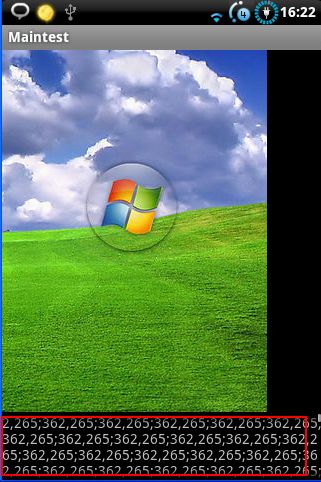Android初级教程_获取Android控件的宽和高
我们都知道在onCreate()里面获取控件的高度是0,这是为什么呢?我们来看一下示例:
首先我们自己写一个控件,这个控件非常简单:
public class MyImageView extends ImageView {
public MyImageView(Context context, AttributeSet attrs) {
super(context, attrs);
}
public MyImageView(Context context) {
super(context);
}
@Override
protected void onMeasure(int widthMeasureSpec, int heightMeasureSpec) {
super.onMeasure(widthMeasureSpec, heightMeasureSpec);
System.out.println("onMeasure 我被调用了"+System.currentTimeMillis());
}
@Override
protected void onDraw(Canvas canvas) {
super.onDraw(canvas);
System.out.println("onDraw 我被调用了"+System.currentTimeMillis());
}
}
<com.test.MyImageView
android:id="@+id/imageview"
android:layout_width="wrap_content"
android:layout_height="wrap_content"
android:src="@drawable/test" />
测试的Activity的onCreate():
@Override
public void onCreate(Bundle savedInstanceState) {
super.onCreate(savedInstanceState);
setContentView(R.layout.main);
System.out.println("执行完毕.."+System.currentTimeMillis());
}现在我们现在来看一下结果:
说明等onCreate方法执行完了,我们定义的控件才会被度量(measure),所以我们在onCreate方法里面通过view.getHeight()获取控件的高度或者宽度肯定是0,因为它自己还没有被度量,也就是说他自己都不知道自己有多高,而你这时候去获取它的尺寸,肯定是不行的.
现在碰到这个问题我们不能不解决,在网上找到了如下办法:
//------------------------------------------------方法一
int w = View.MeasureSpec.makeMeasureSpec(0,View.MeasureSpec.UNSPECIFIED);
int h = View.MeasureSpec.makeMeasureSpec(0,View.MeasureSpec.UNSPECIFIED);
imageView.measure(w, h);
int height =imageView.getMeasuredHeight();
int width =imageView.getMeasuredWidth();
textView.append("\n"+height+","+width);
//-----------------------------------------------方法二
ViewTreeObserver vto = imageView.getViewTreeObserver();
vto.addOnPreDrawListener(new ViewTreeObserver.OnPreDrawListener() {
public boolean onPreDraw() {
int height = imageView.getMeasuredHeight();
int width = imageView.getMeasuredWidth();
textView.append("\n"+height+","+width);
return true;
}
});
//-----------------------------------------------方法三
ViewTreeObserver vto2 = imageView.getViewTreeObserver();
vto2.addOnGlobalLayoutListener(new OnGlobalLayoutListener() {
@Override
public void onGlobalLayout() {
imageView.getViewTreeObserver().removeGlobalOnLayoutListener(this);
textView.append("\n\n"+imageView.getHeight()+","+imageView.getWidth());
}
});
这三个方法是哪里找到现在已经忘了.
现在要讨论的是当我们需要时候使用哪个方法呢?
现在把测试的Activity改成如下:
@Override
public void onCreate(Bundle savedInstanceState) {
super.onCreate(savedInstanceState);
setContentView(R.layout.main);
final ImageView imageView = (ImageView) findViewById(R.id.imageview);
//------------------------------------------------方法一
int w = View.MeasureSpec.makeMeasureSpec(0,View.MeasureSpec.UNSPECIFIED);
int h = View.MeasureSpec.makeMeasureSpec(0,View.MeasureSpec.UNSPECIFIED);
imageView.measure(w, h);
int height =imageView.getMeasuredHeight();
int width =imageView.getMeasuredWidth();
textView.append("\n"+height+","+width);
System.out.println("执行完毕.."+System.currentTimeMillis());
}

接着来看下面几种方式输出结果:
把测试Activity改成如下:
@Override
public void onCreate(Bundle savedInstanceState) {
super.onCreate(savedInstanceState);
setContentView(R.layout.main);
final ImageView imageView = (ImageView) findViewById(R.id.imageview);
//-----------------------------------------------方法二
ViewTreeObserver vto = imageView.getViewTreeObserver();
vto.addOnPreDrawListener(new ViewTreeObserver.OnPreDrawListener() {
public boolean onPreDraw() {
int height = imageView.getMeasuredHeight();
int width = imageView.getMeasuredWidth();
textView.append("\n"+height+","+width);
return true;
}
});
}
结果如下:
方法三就不再测试了同方法二!!!
那么方法而和方法三在执行上有什么区别呢?
我们在布局文件中加入一个TextView来记录这个控件的宽高.
<ScrollView
android:layout_width="wrap_content"
android:layout_height="wrap_content" >
<TextView
android:id="@+id/text"
android:layout_width="wrap_content"
android:layout_height="wrap_content" />
</ScrollView>
先来测试方法而:
@Override
public void onCreate(Bundle savedInstanceState) {
super.onCreate(savedInstanceState);
setContentView(R.layout.main);
final ImageView imageView = (ImageView) findViewById(R.id.imageview);
//-----------------------------------------------方法二
ViewTreeObserver vto = imageView.getViewTreeObserver();
vto.addOnPreDrawListener(new ViewTreeObserver.OnPreDrawListener() {
public boolean onPreDraw() {
int height = imageView.getMeasuredHeight();
int width = imageView.getMeasuredWidth();
textView.append("\n"+height+","+width);
return true;
}
});
}
结果如下:
我们再来测试方法三
@Override
public void onCreate(Bundle savedInstanceState) {
super.onCreate(savedInstanceState);
setContentView(R.layout.main);
final ImageView imageView = (ImageView) findViewById(R.id.imageview);
//-----------------------------------------------方法三
ViewTreeObserver vto2 = imageView.getViewTreeObserver();
vto2.addOnGlobalLayoutListener(new OnGlobalLayoutListener() {
@Override
public void onGlobalLayout() {
imageView.getViewTreeObserver().removeGlobalOnLayoutListener(this);
textView.append("\n\n"+imageView.getHeight()+","+imageView.getWidth());
}
});
}
输出结果如下:
我想这方法二和方法三之间的区别就不用说了吧.
总结:那么需要获取控件的宽高该用那个方法呢?
方法一: 比其他的两个方法多了一次计算,也就是多调用了一次onMeasure()方法,该方法虽然看上去简单,但是如果要目标控件计算耗时比较大的话(如listView等),不建议使用.
方法二,它的回调方法会调用很多次,并且滑动TextView的时候任然会调用,所以不建议使用.
方法三,比较合适.
当然,实际应用的时候需要根据实际情况而定.
谢谢!! 欢迎转载:http://blog.csdn.net/johnny901114/article/details/7839512



